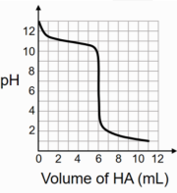
A 0.1 M weak base (B) solution is titrated with 0.1 M of a strong acid (HA). The image below depicts the change in pH of the solution as a function of the amount of HA added. What is the \[p{k_b}\] of the base? The neutralisation reaction is given by \[B + HA - \]\[B{H^ + } + {A^ - }\].

Answer
221.1k+ views
Hint: In general, titration is a type of quantitative analysis that involves measuring the volume of a chemical species' solution in a suitable solvent in order to estimate its quantity. The Law of Equivalence underpins this strategy. As a result, titration can be defined as the process of calculating the volume of reagents by bringing a specific reaction to a close. The titrant is the solution used in titration that has an accurate concentration and the titrated substance is the substance whose volume needs to be determined.
Complete Step by Step Solution:
The given chemical reaction is \[B + HA \to B{H^ + } + {A^ - }\]
At Equivalence Point:
Total vol. = 12 ml
Concentration of salt = \[\dfrac{{0.6}}{{12}}\]
pH = 6 = \[\sqrt {\dfrac{{{k_w}}}{{{k_b}}}} \times c = \sqrt {\dfrac{{{{10}^{ - 14}} \times 0.6}}{{{k_b} \times 12}}} \]
{ pH = 0.6, \[[{H^ + }] = {10^{ - 6}}\]}
\[ \Rightarrow \]pH = 0.6 = \[\sqrt {\dfrac{{{k_w}}}{{{k_b}}} \times \dfrac{{0.1 \times 6}}{{12}}} \]
\[{10^{ - 12}} = \dfrac{{{{10}^{ - 14}} \times {{10}^{ - 1}}}}{{{k_b}}} \times \dfrac{1}{2}\]
$ \Rightarrow {k_b} = 5 \times {10^{ - 4}} \\$
$ \Rightarrow p{k_b} = - \log {k_b} = - \log (5 \times {10^{ - 4}}) = - \log 5 + 4\log 10 \\$
$ \Rightarrow p{k_b} = 4 - 0.7 \\$
$ \Rightarrow p{k_b} = 3.3 \\ $
Note: \[p{k_b}\] is the symbol which is used to estimate the alkalinity of the molecule. It is used to determine the base's strength. The lesser the \[p{k_b}\] value, the more potential the base will be having to dilute an acid. It is equivalent to the negative of logarithm of the base dissociation constant i.e. \[{k_b}\].
\[p{k_b} = - \log {k_b}\]; \[{k_b}\] or base dissociation constant is the symbol used to estimate a base’s strength. It indicates the amount of dissociation of a base in an aqueous solution. \[{k_b}\] is used to distinguish a strong base from a weaker one. More the value of \[{k_b}\] more would be its dissociation.
Complete Step by Step Solution:
The given chemical reaction is \[B + HA \to B{H^ + } + {A^ - }\]
| Conditions | B (0.1 M) | HA (0.1 M) | pH |
| At V = 0 ml | 0 ml | 13 | |
| At V = 3 ml | 3 ml → 50% neutralisation | 11 | |
| At V = 6 ml | 6 ml → Equivalence Point | 3 to 9 |
At Equivalence Point:
| B | HA | BH+ | A- |
| $0.1 \times 6$ = 0.6 mmol | $0.1 \times 6$ = 0.6 mmol | ||
| 0 | 0 | 0.6 mmol |
Total vol. = 12 ml
Concentration of salt = \[\dfrac{{0.6}}{{12}}\]
pH = 6 = \[\sqrt {\dfrac{{{k_w}}}{{{k_b}}}} \times c = \sqrt {\dfrac{{{{10}^{ - 14}} \times 0.6}}{{{k_b} \times 12}}} \]
{ pH = 0.6, \[[{H^ + }] = {10^{ - 6}}\]}
\[ \Rightarrow \]pH = 0.6 = \[\sqrt {\dfrac{{{k_w}}}{{{k_b}}} \times \dfrac{{0.1 \times 6}}{{12}}} \]
\[{10^{ - 12}} = \dfrac{{{{10}^{ - 14}} \times {{10}^{ - 1}}}}{{{k_b}}} \times \dfrac{1}{2}\]
$ \Rightarrow {k_b} = 5 \times {10^{ - 4}} \\$
$ \Rightarrow p{k_b} = - \log {k_b} = - \log (5 \times {10^{ - 4}}) = - \log 5 + 4\log 10 \\$
$ \Rightarrow p{k_b} = 4 - 0.7 \\$
$ \Rightarrow p{k_b} = 3.3 \\ $
Note: \[p{k_b}\] is the symbol which is used to estimate the alkalinity of the molecule. It is used to determine the base's strength. The lesser the \[p{k_b}\] value, the more potential the base will be having to dilute an acid. It is equivalent to the negative of logarithm of the base dissociation constant i.e. \[{k_b}\].
\[p{k_b} = - \log {k_b}\]; \[{k_b}\] or base dissociation constant is the symbol used to estimate a base’s strength. It indicates the amount of dissociation of a base in an aqueous solution. \[{k_b}\] is used to distinguish a strong base from a weaker one. More the value of \[{k_b}\] more would be its dissociation.
Recently Updated Pages
The hybridization and shape of NH2 ion are a sp2 and class 11 chemistry JEE_Main

What is the pH of 001 M solution of HCl a 1 b 10 c class 11 chemistry JEE_Main

Aromatization of nhexane gives A Benzene B Toluene class 11 chemistry JEE_Main

Show how you will synthesise i 1Phenylethanol from class 11 chemistry JEE_Main

The enolic form of acetone contains a 10sigma bonds class 11 chemistry JEE_Main

Which of the following Compounds does not exhibit tautomerism class 11 chemistry JEE_Main

Trending doubts
Understanding Atomic Structure for Beginners

Understanding Entropy Changes in Different Processes

Common Ion Effect: Concept, Applications, and Problem-Solving

What Are Elastic Collisions in One Dimension?

Free Radical Substitution and Its Stepwise Mechanism

Understanding Geostationary and Geosynchronous Satellites

Other Pages
JEE Advanced 2026 Revision Notes for Practical Organic Chemistry

NCERT Solutions For Class 11 Chemistry Chapter 7 Equilibrium in Hindi - 2025-26

Understanding Centrifugal Force in Physics

JEE Main Marking Scheme 2026- Paper-Wise Marks Distribution and Negative Marking Details

Devuthani Ekadashi 2025: Correct Date, Shubh Muhurat, Parana Time & Puja Vidhi

Difference Between Exothermic and Endothermic Reactions: Key Differences, Examples & Diagrams




